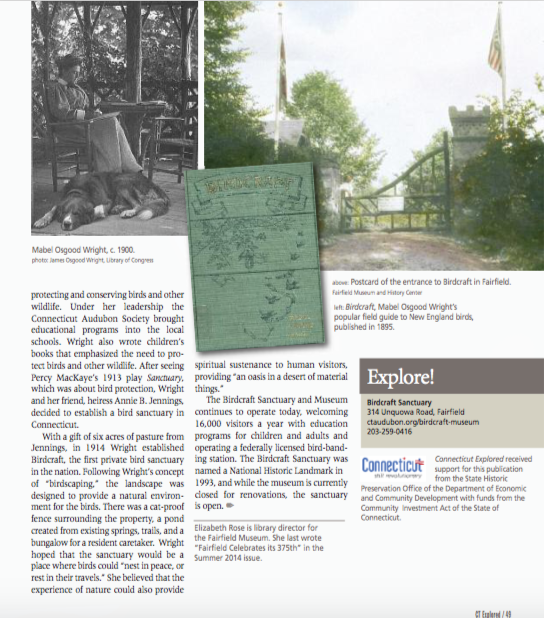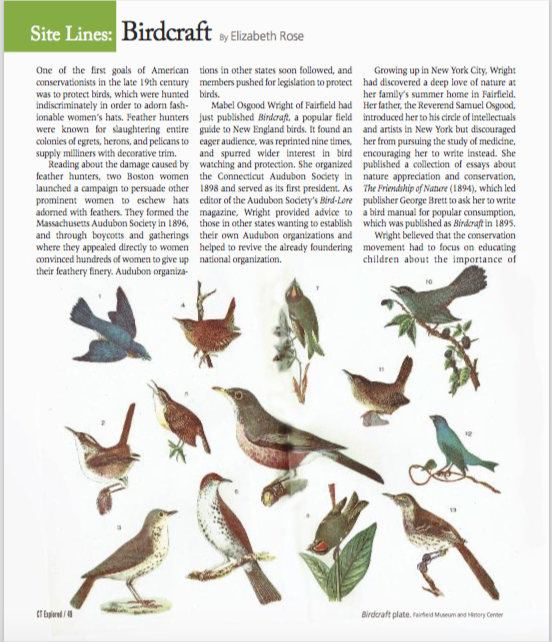(c) Connecticut Explored Inc. Fall 2017
SUBSCRIBE/Buy the Issue
One of the first goals of American conservationists in the late 19th century was to protect birds, which were hunted indiscriminately in order to adorn fashionable women’s hats. Feather hunters were known for slaughtering entire colonies of egrets, herons, and pelicans to supply milliners with decorative trim.
Reading about the damage caused by feather hunters, two Boston women launched a campaign to persuade other prominent women to eschew hats adorned with feathers. They formed the Massachusetts Audubon Society in 1896, and through boycotts and gatherings where they appealed directly to women convinced hundreds of women to give up their feathery finery. Audubon organizations in other states soon followed, and members pushed for legislation to protect birds.
Mabel Osgood Wright of Fairfield had just published Birdcraft, a popular field guide to New England birds. It found an eager audience, was reprinted nine times, and spurred wider interest in bird watching and protection. She organized the Connecticut Audubon Society in 1898 and served as its first president. As editor of the Audubon Society’s Bird-Lore magazine, Wright provided advice to those in other states wanting to establish their own Audubon organizations and helped to revive the already foundering national organization.
Growing up in New York City, Wright had discovered a deep love of nature at her family’s summer home in Fairfield. Her father, the Reverend Samuel Osgood, introduced her to his circle of intellectuals and artists in New York but discouraged her from pursuing the study of medicine, encouraging her to write instead. She published a collection of essays about nature appreciation and conservation, The Friendship of Nature (1894), which led publisher George Brett to ask her to write a bird manual for popular consumption, which was published as Birdcraft in 1895.
Wright believed that the conservation movement had to focus on educating children about the importance of protecting and conserving birds and other wildlife. Under her leadership the Connecticut Audubon Society brought educational programs into the local schools. Wright also wrote children’s books that emphasized the need to protect birds and other wildlife. After seeing Percy MacKaye’s 1913 play Sanctuary, which was about bird protection, Wright and her friend, heiress Annie B. Jennings, decided to establish a bird sanctuary in Connecticut.
 With a gift of six acres of pasture from Jennings, in 1914 Wright established Birdcraft, the first private bird sanctuary in the nation. Following Wright’s concept of “birdscaping,” the landscape was designed to provide a natural environment for the birds. There was a cat-proof fence surrounding the property, a pond created from existing springs, trails, and a bungalow for a resident caretaker. Wright hoped that the sanctuary would be a place where birds could “nest in peace, or rest in their travels.” She believed that the experience of nature could also provide spiritual sustenance to human visitors, providing “an oasis in a desert of material things.”
With a gift of six acres of pasture from Jennings, in 1914 Wright established Birdcraft, the first private bird sanctuary in the nation. Following Wright’s concept of “birdscaping,” the landscape was designed to provide a natural environment for the birds. There was a cat-proof fence surrounding the property, a pond created from existing springs, trails, and a bungalow for a resident caretaker. Wright hoped that the sanctuary would be a place where birds could “nest in peace, or rest in their travels.” She believed that the experience of nature could also provide spiritual sustenance to human visitors, providing “an oasis in a desert of material things.”
The Birdcraft Sanctuary and Museum continues to operate today, welcoming 16,000 visitors a year with education programs for children and adults and operating a federally licensed bird-banding station. The Birdcraft Sanctuary was named a National Historic Landmark in 1993, and while the museum is currently closed for renovations, the sanctuary is open.
Elizabeth Rose is library director for the Fairfield Museum. She last wrote “Fairfield Celebrates its 375th,” Summer 2014.
Explore!
Birdcraft Sanctuary
314 Unquowa Road, Fairfield
ctaudubon.org/birdcraft-museum, 203-259-0416
 Connecticut Explored received support for this publication from the State Historic Preservation Office of the Department of Economic and Community Development with funds from the Community Investment Act of the State of Connecticut.
Connecticut Explored received support for this publication from the State Historic Preservation Office of the Department of Economic and Community Development with funds from the Community Investment Act of the State of Connecticut.

